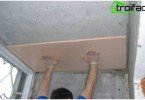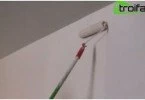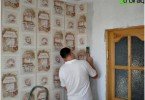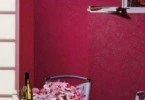Drywall Niche Design Options
Drywall has long won the love of consumers in the construction market. This is due to a fairly wide scope of its application and the ability to completely transform the living room with it. Worthy competition to traditional partitions and ceilings is now created by drywall niches, shelves and small cabinets. Over the past few years, the niches in the walls made of drywall have gained particular popularity.
To date, niches made of drywall, can solve many problems that arise in the process of interior design. So, they allow you to hide any flaws or defects in the finish, hide unsightly communications from prying eyes, help create visual effects and perform a decorative function.
Content
- Types of drywall niches
- Symbiosis of decor and practicality
- Functional niches in the living room
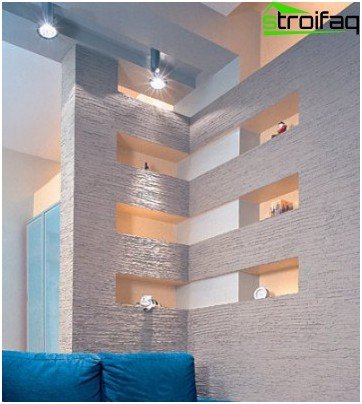
Drywall Niche Helps Transform Space
Types of drywall niches
The variety of options for niches in the wall allows you to combine them into fairly large groups, the main difference between which is one or another criterion.
So, depending on the location of the niche can be divided into:
- Vertical. This type of design allows you to create a certain visual effect, which is often simply necessary in some rooms. In particular, a vertical niche will create the illusion of a high ceiling, will allow you to somewhat balance the space of a room if there is a long wall in it. This design is especially attractive in the immediate vicinity of a window or cabinet..
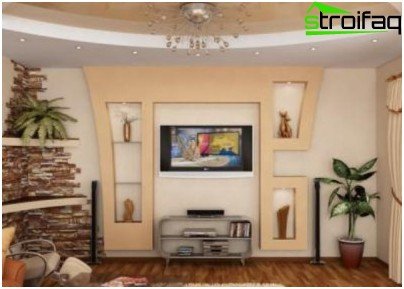
A vertical niche in the interior will visually increase the height of the ceilings
- Horizontal Such niches made of drywall allow, on the contrary, to visually lengthen the wall. It will look great next to a low sofa..
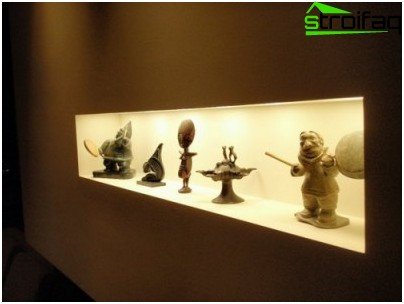
A drywall niche located horizontally optically will expand the boundaries
The purpose of the niche determines whether it will:
- decorative;
- functional.
Symbiosis of decor and practicality
As a rule, decorative niches are used to store various souvenirs, figurines, photographs. Small pots with home flowers are often placed in such recesses in the wall. Moreover, if the size of the niche allows, then you can place an aquarium in it. Design options for a decorative niche are limited only by the imagination of the owner of the house and, perhaps, by a stylistic decision. It is unlikely that a niche decorated in a country style will organically look indoors in a hi-tech style (hi-tech).
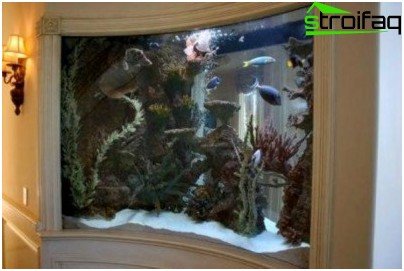
The aquarium in the niche will “bind” diverse interior elements
Particular attention should be paid to the issue of highlighting niches. It contributes to the creation of various visual effects, for example, expanding the space of a niche, making it deeper. In addition, the play of light in glass products located in a niche is especially beautiful in the evening. For illumination, light sources of various intensities and shapes can be used..
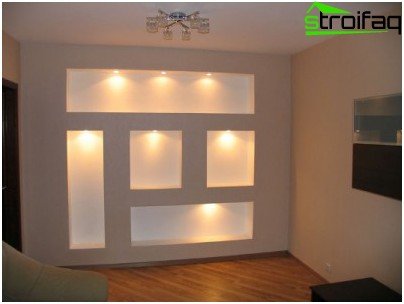
Illuminated drywall niche is an interesting way to provide additional lighting
Decorative niches are a great option for those who like constant changes in their surroundings. It is enough to update the contents of the niche, rearrange souvenirs, completely change its color scheme, and the updated interior is already pleasing to the eye.
Functional niches in the living room
A distinctive feature of functional niches is that they are designed directly for placement of certain interior items in them. This may be household appliances (a niche for a plasterboard TV set), furniture (wardrobe, recessed into a niche) or interior items.
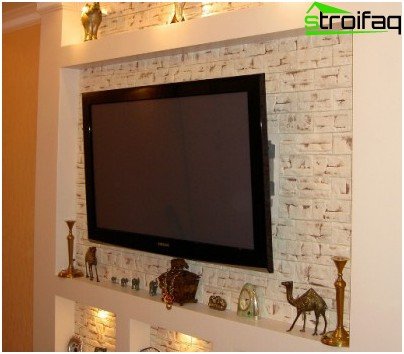
Plasterboard Niche for TV
In addition, functional niches in the walls are often equipped to mask various communications. This is especially true for bathrooms. So the niche that hides the water supply pipes can have several convenient shelves on which dry towels and various cosmetics can easily be placed.
Larger niches in the bathroom allow washing machines or showers to be placed in them..
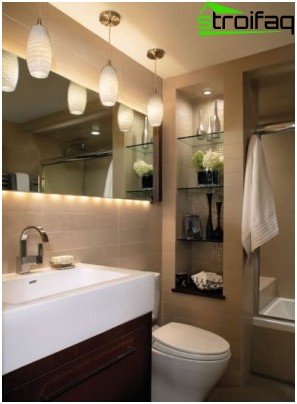
A niche made of drywall in the bathroom will serve well if it is made of a material with water-repellent properties
Device and finish
Niches can be built in the walls of almost any material. It can be brick, wood or concrete. It is worth noting that the technology for making a niche in the wall from drywall is quite simple. It is only necessary to determine in advance its form and purpose. Then it is enough to make the appropriate frame and sheathe it with sheets of drywall. With a certain wetting of the material, it can be bent at a certain degree, forming, for example, an arch.
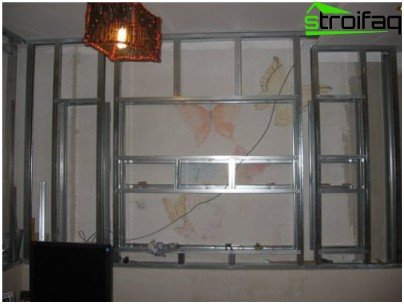
Drywall Niche Frame
Finishing the niche itself can also be made from a wide variety of materials. It can be stone, metal, glass, decorative plaster or traditional wallpaper. So the surface of the niche can be smooth or embossed, and the color scheme can match the color scheme of the walls or contrast with it. However, experts note that too dark colors are not suitable for niches, especially if the wall has a light tone. In this case, niches are more like holes in the wall than a functional and decorative interior solution.
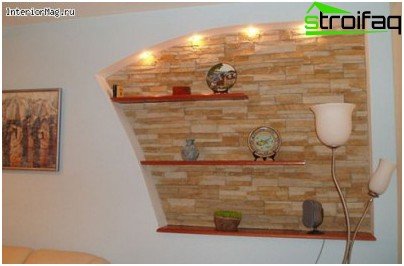
Plasterboard niche trim with artificial stone
Niches can be built with the help of qualified specialists who will develop a niche project, its design, advise on the optimal solution depending on the area and configuration of the living space. However, in this case it is necessary to adequately pay for the work of specialists. You can save if you make niches from drywall with your own hands. However, it will take time to study the relevant information..
Thus, today there are a huge number of very different design options for drywall niches in the wall. The implementation of one or another of them depends on the possibilities, desires and boundaries of fantasy.


